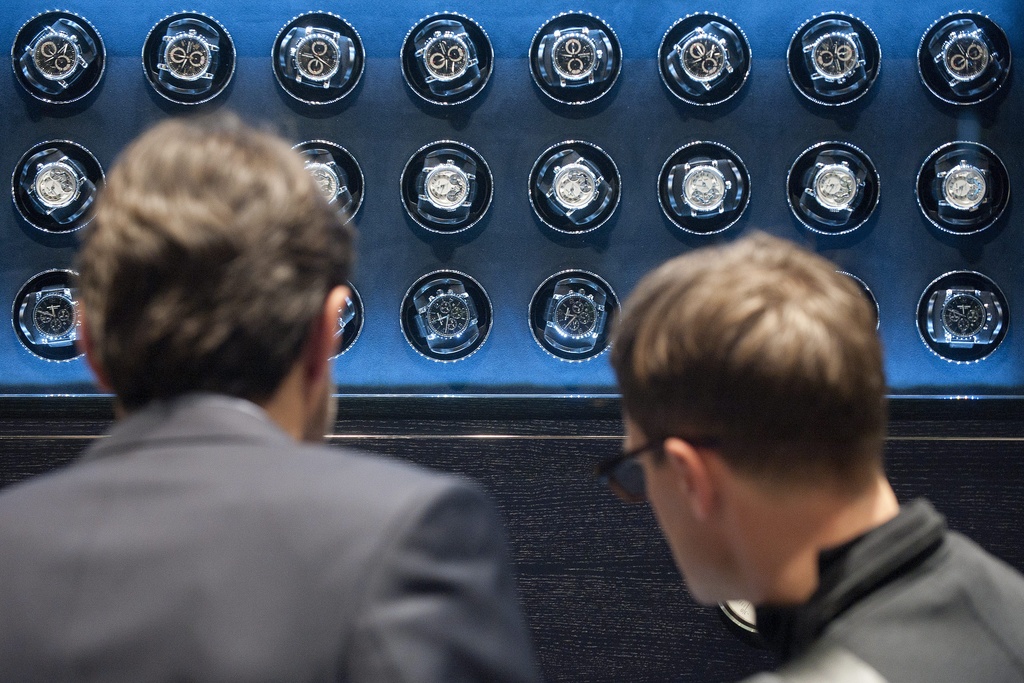Cracking the Chinese luxury goods market

Another Swiss company making premium goods is attempting to break into the lucrative Chinese market.
Thirty-nine-year-old billionaire Philippe Gaydoul tells swissinfo.ch why he wants to expand by trying to sell his Navyboot, Fogal and other brands in China.
In 2000, Gaydoul took over at the helm of Denner, the discount retailer founded by his grandfather, Karl Schweri. In 2007, Gaydoul sold Denner to Switzerland’s largest retailer, Migros, for an undisclosed sum. He then founded the Gaydoul Group, an investment company which focuses on the premium and luxury lifestyle market.
The group currently comprises four brands: Navyboot (shoes and accessories), Fogal (legwear and knitwear), Jet Set (sports fashion) and Hanhart (watches). Navyboot is the first to dip its pedicured toe into Chinese waters.
swissinfo.ch: The Gaydoul Group’s Swiss companies are predominantly active in German-speaking Europe. Now you’re targeting China. A big step!
Philippe Gaydoul: Indeed. It’s clear to us that if you want to expand internationally in the luxury industry, you’re going to have to get involved with China sooner or later. (See sidebar: China, a promising luxury market)
swissinfo.ch: Will you bring all your brands to China?
P.G.: Yes, that’s our mid-term plan. But we’re taking it step by step.
swissinfo.ch: What stage are you at?
P.G.: We’ll open our first five stores in the next 18 months. We’re now in final talks with landlords and shopping malls. We’re also trying to secure locations in malls that are not built yet.
We’re looking at various cities all over China. Finding a suitable location is most difficult in Shanghai. Our first store will most likely be in Hong Kong. But also second-tier cities like Chongqing or Chengdu will be of interest to us in the midterm.
swissinfo.ch: All your brands are completely unknown in mainland China…
P.G.: That’s mostly true, although Fogal is already present in Hong Kong and Japan and is very successful there. We can learn from this experience.
But you have to understand that when I was on the lookout for buying opportunities, I wasn’t eyeing internationally established brands. I was looking at companies with the potential to succeed internationally.
swissinfo.ch: How did you approach China?
P.G.: Gaining a foothold in a new market is always a multilayer approach and we used a combination of different tools.
First, we had to make sure we generated enough profit elsewhere so we could afford to invest in China. Then we set up an office in Hong Kong some 18 months ago. The four employees are a mixture of Hong Kong Chinese and Europeans. They bring in a lot of China knowledge. In addition, I was making use of my personal network, talking to many experienced China businessmen.
swissinfo.ch: What difficulties have you encountered?
P.G.: On an operational level, none so far as we’ve just started! Strategically, the biggest difficulty is clearly the positioning of new and unknown brands in a country as vast as China. Also, making the right contacts is not always easy.
swissinfo.ch: Creating brand awareness is hard and very expensive.
P.G.: True. Brand and image building is a lengthy process and takes at least two to three years. And for each of our brands we have a different game plan. Of course, physical presence with stores is important. We will try to create a buzz in innovative ways – always having the particularities of Asian consumers in mind.
swissinfo.ch: What are the particularities of Chinese consumers?
P.G.: Asian consumers in general are very open-minded and curious, but also very critical and price sensitive.
swissinfo.ch: In the luxury goods industry one gets the impression that price matters the least…
P.G.: Be careful! The phenomenon you’re referring to applies to only a handful of well-established, usually globally known brands. This is not who we are and how we think. We want to deliver content, add value and create emotions.
swissinfo.ch: How important is “Swissness” as a marketing tool?
P.G.: It’s important for Navyboot, as it’s largely Swiss made. We will emphasise Swissness – globally associated with trust and quality – but not too much.
Remember that quality is a basic consumer requirement and nothing to brag about, even in the discount food industry! Hence, by no means can quality be a unique selling point in the luxury goods industry.
swissinfo.ch: Have you done market research in China in order to gain information about consumer behaviour, willingness to pay or taste preferences?
P.G.: We did our homework. We did competitor analysis and looked at some macro data. But I primarily believe in experience rather than statistics. I believe in working with skilled people who have a sense for consumer trends and who view the world with open eyes and have a deep understanding of the market, such as our creative director at Navyboot who has extensive Asia experience.
swissinfo.ch: What are the similarities with your previous job at Denner?
P.G.: Pretty much everything is radically different, except for the family ownership. Denner was foodstuff, discount and uniquely operational in Switzerland. Now we’re expanding internationally with fashion and lifestyle brands in the premium luxury segment.
Fabian Gull is editor-in-chief of The Bridge, the official quarterly magazine of the Swiss Chambers of Commerce in China and Hong Kong.
In a country with an estimated population of 1.3 billion, there are 875,000 multimillionaires and 55,000 billionaires.
Multimillionaires on average own three cars and 4.4 luxury watches
Billionaires on average own four cars and five luxury watches.
China in 2009 surpassed the United States in luxury consumption by making up 27.5% of the global luxury market. It is expected to take over from Japan in the top spot as early as 2015.
The country is the youngest luxury market. 80% of consumers are less than 45 years old. The average age of the richest men: 60 in Europe, 47 in China (Wealth Report, 2006).
Average of the wealthy changed to 39 in 2010.
Collection is one of the most important investments of Chinese multimillionaires Their collections include:
Watches/jewellery: 44%
Ancient calligraphy and paintings 15%
Wine: 13%
Cars: 12%
Contemporary art 7%
(Research by Tingting Mo)
Chinese GDP 2010: $5,878 billion
Change over previous year: +10.3%
Per capita GDP: $4,393
Swiss colony: 3,503
Swiss exports 2010: SFr7.467 billion
Change over previous year: +35.7%
Swiss imports 2010: SFr 6.085 billion
Change over previous year: +17.9%
(Source: Swiss foreign ministry. Data do not include Hong Kong, Macao and Taiwan)
(Adapted by Thomas Stephens)

In compliance with the JTI standards
More: SWI swissinfo.ch certified by the Journalism Trust Initiative













You can find an overview of ongoing debates with our journalists here . Please join us!
If you want to start a conversation about a topic raised in this article or want to report factual errors, email us at english@swissinfo.ch.